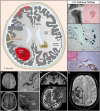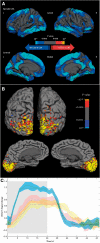Emerging concepts in sporadic cerebral amyloid angiopathy
- PMID: 28334869
- PMCID: PMC6059159
- DOI: 10.1093/brain/awx047
Emerging concepts in sporadic cerebral amyloid angiopathy
Abstract
Sporadic cerebral amyloid angiopathy is a common, well-defined small vessel disease and a largely untreatable cause of intracerebral haemorrhage and contributor to age-related cognitive decline. The term 'cerebral amyloid angiopathy' now encompasses not only a specific cerebrovascular pathological finding, but also different clinical syndromes (both acute and progressive), brain parenchymal lesions seen on neuroimaging and a set of diagnostic criteria-the Boston criteria, which have resulted in increasingly detected disease during life. Over the past few years, it has become clear that, at the pathophysiological level, cerebral amyloid angiopathy appears to be in part a protein elimination failure angiopathy and that this dysfunction is a feed-forward process, which potentially leads to worsening vascular amyloid-β accumulation, activation of vascular injury pathways and impaired vascular physiology. From a clinical standpoint, cerebral amyloid angiopathy is characterized by individual focal lesions (microbleeds, cortical superficial siderosis, microinfarcts) and large-scale alterations (white matter hyperintensities, structural connectivity, cortical thickness), both cortical and subcortical. This review provides an interdisciplinary critical outlook on various emerging and changing concepts in the field, illustrating mechanisms associated with amyloid cerebrovascular pathology and neurological dysfunction.
Keywords: Alzheimer’s disease; cerebral amyloid angiopathy; intracerebral haemorrhage; perivascular drainage; small vessel disease.
© The Author (2017). Published by Oxford University Press on behalf of the Guarantors of Brain. All rights reserved. For Permissions, please email: journals.permissions@oup.com.
Figures






References
-
- Akoudad S, de Groot M, Koudstaal PJ, van der Lugt A, Niessen WJ, Hofman A. et al. Cerebral microbleeds are related to loss of white matter structural integrity. Neurology 2013; 81: 1930–7. - PubMed
-
- Al-Shahi Salman R, Dennis MS. Antiplatelet therapy may be continued after intracerebral hemorrhage. Stroke 2014; 45: 3149–50. - PubMed
-
- Alonzo NC, Hyman BT, Rebeck GW, Greenberg SM. Progression of cerebral amyloid angiopathy: accumulation of amyloid-beta40 in affected vessels. J Neuropathol Exp Neurol 1998; 57: 353–9. - PubMed
Publication types
MeSH terms
Substances
Grants and funding
LinkOut - more resources
Full Text Sources
Other Literature Sources
Medical
Miscellaneous

